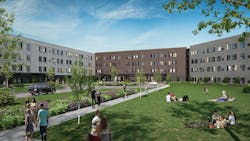P3 student housing project with 176 units slated for Purdue University Fort Wayne
A public/private partnership will fund a four-story, 213,000 sf apartment complex on Purdue University Fort Wayne’s (PFW’s) North Campus in Fort Wayne, Indiana. The P3 entity was formed exclusively for this property. The student housing complex will offer 600 beds across 176 units, with nearly half reserved for university-contracted students while the rest will be available to other area students for direct leasing.
The project will add badly needed housing to the campus. PFW’s student housing has been at full capacity for six consecutive fall semesters, with nearly 1,600 students housed at the start of the 2023-24 academic year—an increase of nearly 21% from the previous year. Housing options will include studios to four-bedroom units.
“The dynamics of the Purdue Fort Wayne campus have changed dramatically during the past few years,” said Chancellor Ron Elsenbaumer. “The university is focused on bringing more people to the area to help fill the employee pipeline. Student housing is an essential component of that strategy. Having sufficient on-campus housing to meet the growing demand is also critical to our ability to create the residential campus environment our students and their families have come to expect.”
The complex, designed to have minimal impact on the surrounding neighborhood, will include a generous public drop-off area for campus shuttles and rideshares, as well as strategic parking placement with over 450 spaces to complement multiple pedestrian connections. Outdoor amenities include a hammock farm, green spaces, sand volleyball and basketball courts, grilling areas, and fire pits. Inside, shared spaces include: a convenience store, fitness center, gaming room, quiet study spaces, lounges, reception area, and leasing office.
The project emphasizes sustainability, incorporating energy-efficient appliances and lighting, water conservation measures, native landscaping, stormwater treatment, and construction waste management strategies. Preliminary work on the $90-$100 million project is slated to begin in October, with completion targeted for the fall 2026 semester.
Owner and/or developer: Gilbane Development Company
Design architect: Progressive AE
Architect of record: Progressive AE
MEP engineer: Progressive AE
Structural engineer: Progressive AE
General contractor: American Village Builders (AVB)
CM Agent: Gilbane Building Company
